Col. Sudhir Farm




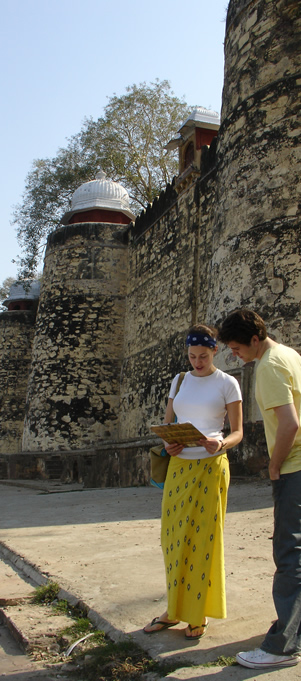





Snippets from the Visitors' Book
The Kota tonga trail was a real highlight - a bit like a 19th Century treasure hunt. It’s full of little nuggets of unusual information and fascinating glimpses into the unsolved mysteries of Kota.
Harriet and Will, London. UK
The memorial to Major Burton and his sons was much more moving than the Taj Mahal or the lake at Udaipur, marvellous as they are.
Henry Vane, Cumbria, UK
...the most comfortable bed I’ve slept in for 2 months....
Charlotte Adam, Winchester UK
Two days out of the noise and the people in a beautiful place. We felt totally
at home
- To be recommended to every person who wishes to experience the Indian country life. We also liked the way the food was prepared...
Patrick & Marie-Christine Lemaigre, Nil-St Vincent, Belgium
We’re only here for the porridge and home made bread! Thank you for a most wonderful time the memories of which we shall carry always. You have given us a wonderful & fascinating introduction to India.
Sue Turner, Lancashire, UK
So ...Rajasthan is not all desert! Thank you for sharing everything with us....
The Read family, London, UK
What a wonderful time we’ve had at the school in the village, at the weavers’, on the river, atop a tonga! Thank you for all your help and contacts throughout India
Anne Gerbner, Philadelphia, USA
It was a wonderful stay and thank you for giving us such a positive look at India and Rajasthan.
Salma Goldstein, New Jersey, USA
- There once was a lady of Kota
- Who took visitors out in her motor
- With the roads and the ruts
- It took quite some guts
- To go out with the lady of Kota.
- But once back at home on the farm
- The world quite descended to calm
- With the plants and the birds
- And fox terriers in herds
- There was balm in the calm on the farm.
Sue Millar, London, UK
After travelling around Rajasthan for two weeks, reaching a real house with books on the shelves, photos on the walls and four happy dogs was simply wonderful.
Camille Savinien, Paris, France
This isn’t tourism. I know of nowhere else where you can experience the real India as well as on your traditional working Rajasthani farm.
Sam Milward, Wellington, New Zealand
Thank you so very much for such a wonderful stay - what a fantastic introduction to India. I don’t think we’ll find such tranquillity elsewhere.
Lizzie Fortune, Hampshire. UK
Fabulous - I’ve been spoilt. It’s hard to leave and face the real world.
Elisabeth Simson, Isle of Wight, UK
After travelling around Rajasthan for two weeks, reaching a real house with books on the shelves, photos on the walls and four happy dogs was simply wonderful.
Camille Savinien, Paris, France
This isn’t tourism. I know of nowhere else where you can experience the real India as well as on your traditional working Rajasthani farm.
Sam Milward, Wellington, New Zealand
Thank you so very much for such a wonderful stay - what a fantastic introduction to India. I don’t think we’ll find such tranquillity elsewhere.
Lizzie Fortune, Hampshire. UK
Our visit at the farm was truly wonderful, off the beaten track it is a slice of India a visitor does not normally experience. Victoria is very knowledgeable about Indian culture and the people - an added perspective for us. The food here was very delicious: organically home grown ingredients, vegetables, fruits, grains prepared simply homestyle. A nice change from curries. Enjoyed the early morning boat ride and walk to the weavers. Many thanks.
Johanna Janssens, Washington, USA
I loved staying with you and the dogs and playing with the toys.
Jonas aged 8, Switzerland
A very welcome break from the crazy world of India – wonderful house, food and hospitality. Thank you so much.
Katie Buxton, Bath, UK
I loved seeing the crocodiles, and I learned a lot about deticking the puppies. Coming to the farm was a great experience.
Stella Bartholet, Washington, USA
A wonderful eye opening visit in every sense. We will be back! Thank you!
Christopher & Joanna Hobson, Northamptonshire, UK
A blissfully peaceful stay. We enjoyed everything – even the power cut. Thank you for lovely food, good company and very interesting trips.
Vicky Stark, London, UK
Exactly what we hoped for and more, bits of India off the tourist track, life as it actually is in villages, teeming life and livestock and the magic of the river.
Sir Hilary Miller, Worcester, UK
Thank you for the introduction to miniature painters, wall paintings, stories, great food, good company, walk through the fields. I loved the paintings in the City Palace and go back full of inspiration and memories.
Nan Mulder, Edinburgh, UK

On the Farm - 2019 Archive
On the Farm - December ’19
December night temperatures started at 15oC and dropped to 4oC with minus temperatures in western and northern Rajasthan.
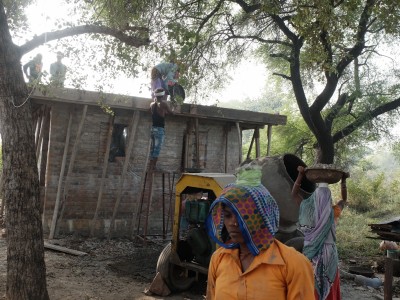 We had a good day for concreting the toilet block roof on 2nd December. Three young couples from Jhabua in Madhya Pradesh came as labourers and worked as an efficent team feeding the cement mixer monster and passing the mixed concrete up to the one on the roof who laid it. One woman was breast feeding and would take a break to feed her 12 month old baby slung in a sari between two trees while the others adjusted accordingly. They started at 12:20 hrs. and worked non stop for four hours.
We had a good day for concreting the toilet block roof on 2nd December. Three young couples from Jhabua in Madhya Pradesh came as labourers and worked as an efficent team feeding the cement mixer monster and passing the mixed concrete up to the one on the roof who laid it. One woman was breast feeding and would take a break to feed her 12 month old baby slung in a sari between two trees while the others adjusted accordingly. They started at 12:20 hrs. and worked non stop for four hours.
Once the roof had been laid it was watered twice daily until 21st December to cure it and then the shuttering was removed. No further work happened in December as the local workforce found it too cold to work and remained hunched near little fires we were told.
 Meanwhile the work of removing the pral (rice straw) either by tractor trolley or in head loads continued. We were paid Rs. 500 a bigha for the rice straw as fodder, slightly up on last year’s price.
Meanwhile the work of removing the pral (rice straw) either by tractor trolley or in head loads continued. We were paid Rs. 500 a bigha for the rice straw as fodder, slightly up on last year’s price.
Once the gullas of rice straw had been removed the fields could be ploughed and watered and prepared for growing wheat.
 The seed drill is being filled with an equal mixture of wheat seed variety 4037 and DAP fertiliser. The wild boar for miles around seem to know when wheat has been planted and are very likely to turn up on the first night snuffling along the rows eating the grain as they go. Pigs and nilgai were nightly visitors, as well as rhesus monkeys during the day. One night jackals were heard close by. Twenty years ago jackals were daily visitors and their strange human-like wailing sound sometimes terrified guests but we rarely hear them that close any more.
The seed drill is being filled with an equal mixture of wheat seed variety 4037 and DAP fertiliser. The wild boar for miles around seem to know when wheat has been planted and are very likely to turn up on the first night snuffling along the rows eating the grain as they go. Pigs and nilgai were nightly visitors, as well as rhesus monkeys during the day. One night jackals were heard close by. Twenty years ago jackals were daily visitors and their strange human-like wailing sound sometimes terrified guests but we rarely hear them that close any more.
 We built two "scarepigs" and in this end of December photograph you can see one looming in the mist. The mustard is in full flower and the rock bees have arrived and have taken up residence.
We built two "scarepigs" and in this end of December photograph you can see one looming in the mist. The mustard is in full flower and the rock bees have arrived and have taken up residence.
Happy New Year
On the Farm - November ’19
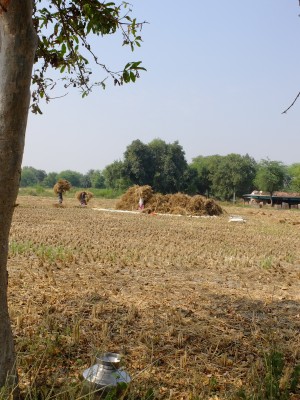

November was a month devoted to rice. By the 10th the cut bundles had dried out enough despite unseasonal rain at the beginning of the month to pile up into heaps called gallas. On the 11th threshing started and went on intermittently until the 30th.
 Once the grain has been extracted the problem remains of huge piles of rice straw or pral which have to be removed.
Some was moved in headloads to the side of the field. Here you can see Dashrath and Ritu gleaning for rice with head loading going on in the background. Some was sold and was removed in ungainly overloaded tractor trolley loads.
Once the grain has been extracted the problem remains of huge piles of rice straw or pral which have to be removed.
Some was moved in headloads to the side of the field. Here you can see Dashrath and Ritu gleaning for rice with head loading going on in the background. Some was sold and was removed in ungainly overloaded tractor trolley loads.
 This variety of rice is like basmati and cattle can eat the relatively delicate stalks but larger grains of rice grow on sturdier stalks which animals don’t want to eat, and so, since it is in nobody’s interest to pick it up from the fields after a combine has scattered it around, the farmer burns it leading to inevitable air pollution problems. We use a halfway type of process which involves hand cutting so the stalks left in the ground are short and will bio-degrade and mechanical threshing which results in the straw being deposited in piles and usable as fodder. It is still labour intensive though and we are lucky having a team of 10 women willing to do such hard work. This peaceful rural scene shows the women working in the background and the cows enjoying the freedom to graze in the rice fields watched over by Mewa Lal.
This variety of rice is like basmati and cattle can eat the relatively delicate stalks but larger grains of rice grow on sturdier stalks which animals don’t want to eat, and so, since it is in nobody’s interest to pick it up from the fields after a combine has scattered it around, the farmer burns it leading to inevitable air pollution problems. We use a halfway type of process which involves hand cutting so the stalks left in the ground are short and will bio-degrade and mechanical threshing which results in the straw being deposited in piles and usable as fodder. It is still labour intensive though and we are lucky having a team of 10 women willing to do such hard work. This peaceful rural scene shows the women working in the background and the cows enjoying the freedom to graze in the rice fields watched over by Mewa Lal.
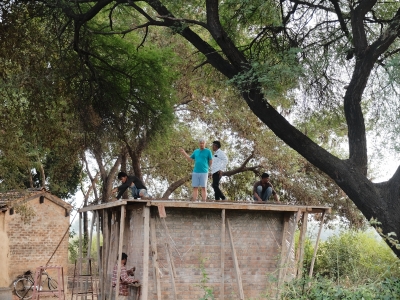 The toilet block finally got going again after the monsoon as the ground was hard enough for the site to be accessed by vehicles with roofing materials. On 27th November the material was delivered and two men worked for three days putting up the shuttering and laying the reinforcement bars. Concreting day was scheduled for 2nd December.
The toilet block finally got going again after the monsoon as the ground was hard enough for the site to be accessed by vehicles with roofing materials. On 27th November the material was delivered and two men worked for three days putting up the shuttering and laying the reinforcement bars. Concreting day was scheduled for 2nd December.
On the Farm - October ’19
More torrential rain. We thought we’d reached the end of the monsoon but on 1st and 2nd October another 5.3 cms. fell bringing the total for the monsoon to 148 cms. or 58.2 inches, as measured on the farm. The legacy was mould on interior walls and fungus on the rice. The walls were cleaned with hydrogen peroxide but the rice developed black blobs of fungus which we think is called false smut. The grains were smaller this year which may be due to lack of sun. The grass between the fields grew as tall as the rice and here are Tigger and Doosra finding a way through.
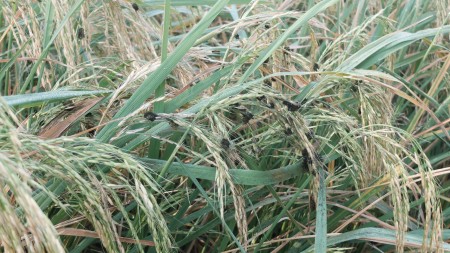

On the 25th rice cutting operations started and here is the team. They cut bundles and laid them to dry. Later the bundles will be fed into a thresher by hand.


 Divali came at the end of the month and Dashrath, and others, lit oil filled diyas and put them around the parapet before a few fireworks and sparklers lit up the night. But air pollution is such an issue that crackers are officially banned and smokey fireworks discouraged.
Divali came at the end of the month and Dashrath, and others, lit oil filled diyas and put them around the parapet before a few fireworks and sparklers lit up the night. But air pollution is such an issue that crackers are officially banned and smokey fireworks discouraged.
 We get the leepna done every year after the monsoon and usually that means the end of September. These women came on 16th October.
We get the leepna done every year after the monsoon and usually that means the end of September. These women came on 16th October.
Other activities on the farm included planting 30 bighas of mustard. Usually, we pre-irrigate but this year it was judged that the ground was wet enough and it was sown on the 17th without pre-irrigation. In some fields the trampling of the cows hooves had compacted the soil so that it had to be ploughed three times rather than twice. We would like to get rid of most cows but there is no legal way to do it.
On the Farm - September ’19
Another 20.08 cms. this month and it rained on sixteen days. The muddy track had started to dry out but on the 12th there was 3.3 cms. of rain in 1.5 hours and the monsoon became active again. Because the reservoirs were full the authorities released a lot of water and all nineteen gates of the Kota Barrage were opened leading to flooding in low lying areas of the town.
 Befor the rain started again the masons came and fitted stone lintels for the doors of the toilet block and reinforced brick lintels over the windows. By 9th September it was ready for the roof.
Befor the rain started again the masons came and fitted stone lintels for the doors of the toilet block and reinforced brick lintels over the windows. By 9th September it was ready for the roof.
 Greenery sprouted dramatically and an area beside the irrigation minor which was last cleared four years back by slashing and burning has now been named the Butterfly Walk. Various trees have self-seeded including shisham, kadam, khair and deshi babool and lantana and other shrubs have filled the ditches. The grass was cut before this picture to make it walkable. The palas or flame of the forest had been there before.
Greenery sprouted dramatically and an area beside the irrigation minor which was last cleared four years back by slashing and burning has now been named the Butterfly Walk. Various trees have self-seeded including shisham, kadam, khair and deshi babool and lantana and other shrubs have filled the ditches. The grass was cut before this picture to make it walkable. The palas or flame of the forest had been there before.
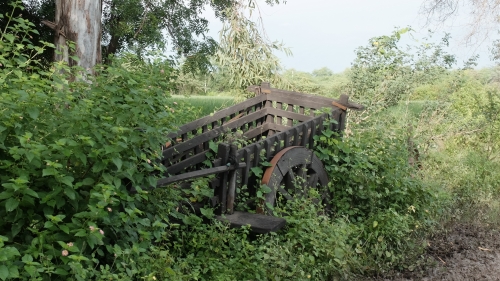 This photo sums up this year’s monsoon and the struggle to maintain property. Mould grew on the interior walls and roofs leaked where they hadn’t leaked before. The rice thrived but the worry is that it will develop fungus in the high humidity and late rains, and the grains underdevelop for the lack of sunlight.
This photo sums up this year’s monsoon and the struggle to maintain property. Mould grew on the interior walls and roofs leaked where they hadn’t leaked before. The rice thrived but the worry is that it will develop fungus in the high humidity and late rains, and the grains underdevelop for the lack of sunlight.
On the Farm - August ’19
 The most significant feature of August 2019 was the record rainfall. After July’s 50.74 cms. or 20" we had 68.19 cms. or nearly 27" in August, giving a total of 118 cms. or 47" in two months. Luckily we upgraded our old thermos rain gauge to a larger one as 10 cms. could fall in 2 hrs and would fill up the thermos. The volume of the water collected was divided by the area of the funnel to give the rainfall measurement. (Spot the thermos and funnel!)
The most significant feature of August 2019 was the record rainfall. After July’s 50.74 cms. or 20" we had 68.19 cms. or nearly 27" in August, giving a total of 118 cms. or 47" in two months. Luckily we upgraded our old thermos rain gauge to a larger one as 10 cms. could fall in 2 hrs and would fill up the thermos. The volume of the water collected was divided by the area of the funnel to give the rainfall measurement. (Spot the thermos and funnel!)
 The water level in the well was the highest ever noted and water was standing around the cow shed and workers houses so the three children living on the farm looked marooned inside for a few days. No work could be done on the toilet block and a new use was found for it as a dry home for the calves.
The water level in the well was the highest ever noted and water was standing around the cow shed and workers houses so the three children living on the farm looked marooned inside for a few days. No work could be done on the toilet block and a new use was found for it as a dry home for the calves.
Local rivers burst their banks and Kaithoon, a local town, was flooded. All dams were full by the end of the month. With gates of the barrage open, the River Chambal was restored to full majesty.This in an area dry and desparate for water in June.
By 26th August most flood water had drained away, but our drive
was still so muddy and rutted that only our trusty 4-wheel drive Gypsy could traverse it.


During the rain upto 29 women were given employment weeding the rice from 6th - 22nd August. They were paid Rs. 180 a day. No one else we knew of was providing weeding employment for them as it is cheaper to spray herbicide/weedicide. The rain sodden cows sploshed about looking for green fodder in the water logged fields and the milk became very watery.
 Amidst all this rain, the transformer feeding electricity to our main boring pump stopped working inexplicably. We took it down, hoping to transport it to the central power house in Nayapura, Kota and exchange it the next day, but the procedure has been changed where a working transformer is delivered to the consumer and the faulty one taken away - as it should be. The replacement transformer was fixed on Friday the 23rd.
Amidst all this rain, the transformer feeding electricity to our main boring pump stopped working inexplicably. We took it down, hoping to transport it to the central power house in Nayapura, Kota and exchange it the next day, but the procedure has been changed where a working transformer is delivered to the consumer and the faulty one taken away - as it should be. The replacement transformer was fixed on Friday the 23rd.
 And here is little Rima, nearly one and standing, enjoying being outside her home on dry land. Rima’s father Amarlal is one of our wokers.
And here is little Rima, nearly one and standing, enjoying being outside her home on dry land. Rima’s father Amarlal is one of our wokers.
On the Farm - July ’19
 The monsoon got off to a good start with 19.5 cms. of rain before 10th July. The men flooded the paddy fields, the tractor churned up the mud and this team of 11 women transplanted the rice seedlings in rain or shine. Here they are bent double in the rain wearing plastic capes with hoods and working for roughly Rs. 215 a day.
The monsoon got off to a good start with 19.5 cms. of rain before 10th July. The men flooded the paddy fields, the tractor churned up the mud and this team of 11 women transplanted the rice seedlings in rain or shine. Here they are bent double in the rain wearing plastic capes with hoods and working for roughly Rs. 215 a day.
The women worked from 10th July - 21st until they had planted 53 bighas of rice. Other fields had been green manured with dhaincha and as fodder for the cows.
 It became very hot as we had no rain from 10th July - 25th and temperatures touched 38oC with high humidity. But from 25th - 31st another 31.28 cms. fell making a total of 50.74 cms. or 20". Many of the reservoirs had been dry and Jaipur was rumoured to be a mere few days from running out of water. The grass had had its annual cut before the monsoon using serated curved sickles used for cutting rice and known as Bihari dentalis. The roots were quite brown as you might just be able to discern under the rain water.
It became very hot as we had no rain from 10th July - 25th and temperatures touched 38oC with high humidity. But from 25th - 31st another 31.28 cms. fell making a total of 50.74 cms. or 20". Many of the reservoirs had been dry and Jaipur was rumoured to be a mere few days from running out of water. The grass had had its annual cut before the monsoon using serated curved sickles used for cutting rice and known as Bihari dentalis. The roots were quite brown as you might just be able to discern under the rain water.

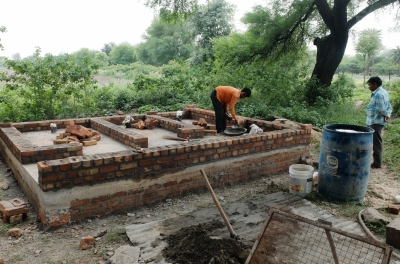
The walls of the toilet block started to come up above the plinth. A young mason Daleep and his young labouring wife with two young children came on the 16th and worked for four days before leaving to go back to their village. After four days of work three courses of English bond brick work had been laid. Work was slow for various reasons, one of them being that Daleep had no prior experience of laying an English bond. No further work was done in July to the frustration of its future users.
 A strange and unfortunate incident on 22nd July was the sudden and inexplicable death of this cow. For a forgotten reason she was called Modi in 2014 and her calf Abhimanyu was named after the Indian Pilot who shot down a Pakistani F-16 and was in turn shot down from ground fire in February. She was found on her side at 4.30 pm in the bara or cow enclosure and was dead within half-an-hour. She was bloated but no other animal was suffering, so bloat or a snake bite seemed the only causes. But there were no visible signs of external injury or bite. The men from Nagar Nigam (local council) whoc came to take her away declared that she had been bitten by a female monitor lizard. There is no accepted evidence of monitor lizards being venemous and in the absence of a post mortem this explanation will continue to be cited. They had to drag her out of the bara and then transport her on a tractor lift. It is not clear where she would have been taken but her skin would probably been sold. The men who took her away have a contract with the Nagar Nigam to collect all the dead animals but demanded Rs. 1200. They settled for Rs. 900 in the end.
A strange and unfortunate incident on 22nd July was the sudden and inexplicable death of this cow. For a forgotten reason she was called Modi in 2014 and her calf Abhimanyu was named after the Indian Pilot who shot down a Pakistani F-16 and was in turn shot down from ground fire in February. She was found on her side at 4.30 pm in the bara or cow enclosure and was dead within half-an-hour. She was bloated but no other animal was suffering, so bloat or a snake bite seemed the only causes. But there were no visible signs of external injury or bite. The men from Nagar Nigam (local council) whoc came to take her away declared that she had been bitten by a female monitor lizard. There is no accepted evidence of monitor lizards being venemous and in the absence of a post mortem this explanation will continue to be cited. They had to drag her out of the bara and then transport her on a tractor lift. It is not clear where she would have been taken but her skin would probably been sold. The men who took her away have a contract with the Nagar Nigam to collect all the dead animals but demanded Rs. 1200. They settled for Rs. 900 in the end.
The same day,our maid Sugna, was bitten on the heel by a dog belonging to the next door farm. We insisted she went and saw a doctor, who prescribed her a course of anti-rabies injections. She received them for free having BPL (Below Poverty Line) status, being a single woman dependent on her son. We hope she got well stored and current vaccinations.
 And to end on a more cheerful note, these are our first ever katel or jackfruit grown on the farm on a tree that is at least ten years old. Jackfruit is messy to prepare and it is advisable to wear rubber gloves as they exude a thick white sticky latex, but the flesh is very nutritious and somewhat similar to pork in texture and flavour. The farmworkers got their share and were delighted with natures bounty.
And to end on a more cheerful note, these are our first ever katel or jackfruit grown on the farm on a tree that is at least ten years old. Jackfruit is messy to prepare and it is advisable to wear rubber gloves as they exude a thick white sticky latex, but the flesh is very nutritious and somewhat similar to pork in texture and flavour. The farmworkers got their share and were delighted with natures bounty.
On the Farm - June ’19
 May is usually the hottest month but this time the temperature went up to 47oC in June and was never below 42oC. The workers were unfazed and were glad to be working in the shade. On 1st June five men drilled four holes for the caisson/pillars for the toilets using a manual augur.
May is usually the hottest month but this time the temperature went up to 47oC in June and was never below 42oC. The workers were unfazed and were glad to be working in the shade. On 1st June five men drilled four holes for the caisson/pillars for the toilets using a manual augur.


By 4th June the baffles and the cast iron pipes in the septic tank had been fitted. Most plumbing and sewage pipes in homes are now plastic. Meanwhile the trenches for the foundation for the toilet block were being dug and on 8th June the concrete was poured in the trenches and caissons over steel reinforcement bars to form beams/footings and pillars. A brick wall to take the ground slab was built over the continuous footing and filled with soil and aggregate and the plumber summoned to put in place the soil and drain pipes, but his sister had died and so a delay was inevitable.
 By 26th June the retaining wall was complete, the cast iron plumbing had been done, the steel bar reinforcement for a 6" thick floor was in position over a layer of aggregate and it was ready for pouring of concrete. By the end of the month the concrete slab had been laid and it was left for a week or more to be cured by rain and hosing while under cover of a plastic sheet.
By 26th June the retaining wall was complete, the cast iron plumbing had been done, the steel bar reinforcement for a 6" thick floor was in position over a layer of aggregate and it was ready for pouring of concrete. By the end of the month the concrete slab had been laid and it was left for a week or more to be cured by rain and hosing while under cover of a plastic sheet.


Measures were taken in June to shelter the cows from the searing sun and two tin shed extensions were built. Special Sudanese Sorghum Grass (SSG) was grown to be cut daily for green fodder.
 All wildlife was in search of water and this desperate Shikra came right up to the outside kitchen tap to cool off by dipping its tail feathers in a bucket of water and to drink water. There were some pre-monsoon showers in June which dropped the temperatures below 40oC to everyone’s relief.
All wildlife was in search of water and this desperate Shikra came right up to the outside kitchen tap to cool off by dipping its tail feathers in a bucket of water and to drink water. There were some pre-monsoon showers in June which dropped the temperatures below 40oC to everyone’s relief.
On the Farm - May ’19
 May began with bagging of wheat for the women who had cut it, ourselves, our workers and a few villagers and the rest was sold in the grain market or mandi. Since our wheat had been rained on, the grains were slightly swollen with moisture and the price was down. We received Rs. 1815 a quintal which was more than anticipated as we sold from the farm at Rs. 1780. The women who had cut the wheat were paid in kind - 90 kgs. for each bigha cut and average yield was 7.5 quintals per bigha.
May began with bagging of wheat for the women who had cut it, ourselves, our workers and a few villagers and the rest was sold in the grain market or mandi. Since our wheat had been rained on, the grains were slightly swollen with moisture and the price was down. We received Rs. 1815 a quintal which was more than anticipated as we sold from the farm at Rs. 1780. The women who had cut the wheat were paid in kind - 90 kgs. for each bigha cut and average yield was 7.5 quintals per bigha.
A couple of families from Madhya Pradesh were employed to load and move the bhousa, or chaff, which lay in piles in each field and there was no temptation to stubble burn as the hand cut wheat stubble was short. Where a combine harvester had cut the wheat we used a secondary stubble cutting machine to chop the stalks for fodder. Again no temptation to burn the stubble, but only some residue after the second cutting operation was set alight.
 Dust storms and hot winds are a feature of May and this year (like in May 2017, but less so) we lost a poplar tree on the drive which had been hollowed out by termites and beloved of woodpeckers and spotted owlets.
Dust storms and hot winds are a feature of May and this year (like in May 2017, but less so) we lost a poplar tree on the drive which had been hollowed out by termites and beloved of woodpeckers and spotted owlets.
 The main focus of the month was to get on with a toilet block and septic tank. This couple, Neeru and Sukhli, started digging on 18th May and finished on the 21st. They live beyond the town of Ratlam and have come to a labour camp at Nanta on the outskirts of Kota to find work and possibly water for the summer. They have four young daughters and different combinations of their children turned up on the farm each day.
The main focus of the month was to get on with a toilet block and septic tank. This couple, Neeru and Sukhli, started digging on 18th May and finished on the 21st. They live beyond the town of Ratlam and have come to a labour camp at Nanta on the outskirts of Kota to find work and possibly water for the summer. They have four young daughters and different combinations of their children turned up on the farm each day.
 Here Anju and Pushpa are looking after Baby Vansika. Another couple also came to labour with two very young children. They were given vegetables from the garden each day as well as their pay, probably Rs. 400 each (approx. GBP 4.70). The children were handed packets of biscuits almost every day.
Here Anju and Pushpa are looking after Baby Vansika. Another couple also came to labour with two very young children. They were given vegetables from the garden each day as well as their pay, probably Rs. 400 each (approx. GBP 4.70). The children were handed packets of biscuits almost every day.


Once the hole for the septic tank was dug, it was lined with stone. By the end of May the septic tank had been plastered and was ready for the pipes and baffles.
On the Farm - April ’19
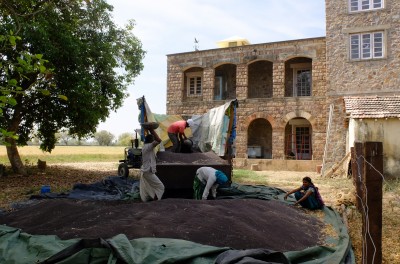 By 1st April the temperature was over 40oC. We loaded the mustard and sent that off to the mandi at the beginning of the month. Rs. 3501 for 100 kgs. is less than last years Rs. 3632 despite it being an election year and agricultural distress a major theme.
By 1st April the temperature was over 40oC. We loaded the mustard and sent that off to the mandi at the beginning of the month. Rs. 3501 for 100 kgs. is less than last years Rs. 3632 despite it being an election year and agricultural distress a major theme.


We had heavy rain and high winds on 16th and 17th April which refreshed and washed all the plants adding a fresh colour and sparkle to them. Luckily, the bulk of the wheat had been harvested by a combine harvester just in time and the crop was protected by heavy plastic sheeting known as tirpals (after tarpauline). The rest of the wheat (in the photographs above) was standing and suffered no serious damage although, ironically, the wheat grains lose colour in the rain and command a lower price because "...colour fade ho gaya." This wheat was cut by women using sickles.
The biggest bee hive in the pipal tree fell in the storm along with the old leaves. Contrast the two photographs above: the first was taken on 16th April and the second on 25th April. Within nine days the pipal tree was resplendent again in fresh green leaves.
 The heritage wheat (C306 variety) which we grow for home consumption was hand cut, tied in bundles and fed into the thresher by hand by the end of the month. The yield is 1/7 of commercial wheat. Notice how much longer and more delicate the stalks are. We grow this in one acre only, so our commercial losses are negligible. Young Dashrath volunteered to help in his school holidays, for which he earned pocket money at the usual labour rates.
The heritage wheat (C306 variety) which we grow for home consumption was hand cut, tied in bundles and fed into the thresher by hand by the end of the month. The yield is 1/7 of commercial wheat. Notice how much longer and more delicate the stalks are. We grow this in one acre only, so our commercial losses are negligible. Young Dashrath volunteered to help in his school holidays, for which he earned pocket money at the usual labour rates.
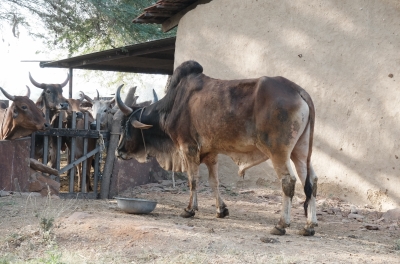 Lhaso, our long serving bull is now 16 and his teeth have worn down and he is having trouble chewing fodder. We bought a bag of channa-ki-churri for him - made from chickpea husk - and here he enjoys his daily ration watched enviously by his companions and progeny.
Lhaso, our long serving bull is now 16 and his teeth have worn down and he is having trouble chewing fodder. We bought a bag of channa-ki-churri for him - made from chickpea husk - and here he enjoys his daily ration watched enviously by his companions and progeny.
 And to finish, a special and typical scene in rural India: the dudh wallah with his many brass charrie buying our milk at the farm gate. We receive Rs. 25 per litre for pure cow’s milk and the rate has not increased for several years. This is said to be because large dairies find it cheaper to buy subsidised milk powder from the EU lake than to buy from the local producers who do not have the advantages of scale and they push the price down.
And to finish, a special and typical scene in rural India: the dudh wallah with his many brass charrie buying our milk at the farm gate. We receive Rs. 25 per litre for pure cow’s milk and the rate has not increased for several years. This is said to be because large dairies find it cheaper to buy subsidised milk powder from the EU lake than to buy from the local producers who do not have the advantages of scale and they push the price down.
On the Farm - March ’19
 This month was traumatic for little Rani who you could see last month being taken in the 4x4 Gypsy to the vet. The tube between her bladder and umblical cord had not closed naturally, as is usual, and urine leaked into her navel causing it to swell up with liquid.
This month was traumatic for little Rani who you could see last month being taken in the 4x4 Gypsy to the vet. The tube between her bladder and umblical cord had not closed naturally, as is usual, and urine leaked into her navel causing it to swell up with liquid.
Two stitches were put in by the Government vet which became infected so her navel filled up with urine and pus and became hard to the touch. We took her to Kota’s new private vet who took out the stitches and prescribed twice daily spraying of her infected navel, and a course of antibiotics for 6 days which Vijay administered every morning, in an attempt to avoid surgery which no one in Kota had the experience or confidence to perform. It seems to have solved the problem and we have to do a follow up course after three weeks. Surgery has been avoided for now.
March was also traumatic for me as I was attacked by some of our many rock bees in my head through my hair and on my forehead and jaw. To be fair to the bees, I had angered them by setting our incinerator alight which is close to their peepal tree home causing smoke and then dousing it with water after they were angered. (I had completely forgotten about the hives when I did that!) I think between 12-20 actually stung me, although a lot refrained. We sprayed anti-histamine on the sting punctures which prevented any swellings, but the venom caused an infection which created internal and external pain. So I went to a hospital and received treatment over the next week. None of the reactions were life threatening but I may have developed an allergy because of the attack. We have several rock bee hives on trees around the house and they have been very threatening in their behaviour several times.

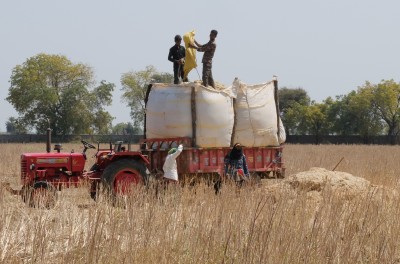
Meanwhile, the mustard was cut and threshed and then stored in the open under a tarpaulin as the price was low.
The mustard chaff/bhoosa was sold at last year’s rate of Rs. 400 a bigha. A tractor-trolley came each day, loaded up and drove straight to the local factory where it will be used as fuel, we were told.
 This year for the first time we grew a small patch of organic flax seed called alsin in Hindi. Each plant had to be harvested individually by plucking out of the surrounding weeds, tied in a bundle, and left to dry. After it was hand threshed we received just under 4.5 kgs. which we could have bought for Rs. 244/kg, that is, Rs. 1098 or 12GBP for the lot. In fact, it took two men a couple of days of work (spread over several days) to pluck, bundle, dry and thresh our harvest. A real super ‘super’ food. But guaranteed organic.
This year for the first time we grew a small patch of organic flax seed called alsin in Hindi. Each plant had to be harvested individually by plucking out of the surrounding weeds, tied in a bundle, and left to dry. After it was hand threshed we received just under 4.5 kgs. which we could have bought for Rs. 244/kg, that is, Rs. 1098 or 12GBP for the lot. In fact, it took two men a couple of days of work (spread over several days) to pluck, bundle, dry and thresh our harvest. A real super ‘super’ food. But guaranteed organic.
 And this year’s Holi picture is of Sita and her two youngest from our farm (three on the left) with her friend and her daughter from the next farm who had obviously enjoyed throwing dry powder colour to celebrate Holi.
And this year’s Holi picture is of Sita and her two youngest from our farm (three on the left) with her friend and her daughter from the next farm who had obviously enjoyed throwing dry powder colour to celebrate Holi.
On the Farm - February ’19
A very pleasant month weather wise with night temperatures between 6oC and 14oC and daytime between 21oC and 34oC but mainly in the mid- to late-twenties and so below the historical average. We had the first foggy day of the winter on 6th February. We had a few misty starts but the sun always broke through.
The green wheat was very vulnerable to marauding nilgai and Vijay was out at least twice every night to chase them off with airgun pellets or a powerful torch when alerted by Doosra’s barking. There were usually a couple but sometimes a group of ten. Fewer pigs this year and less pig damage.
 The mustard finished flowering and as it ripened the fields were full of birds picking off the inevitable aphids. On 14th February we had heavy rain in the evening which washed off the aphids and the rain drops gleamed in the early sun.
The mustard finished flowering and as it ripened the fields were full of birds picking off the inevitable aphids. On 14th February we had heavy rain in the evening which washed off the aphids and the rain drops gleamed in the early sun.
On the 25th a team of twelve women came to start cutting the mustard. When they reached the last field on the 28th a herd of six to seven wild boar were seen to exit.
 The leepner had to be redone after the rain. The young woman on the left grew up on this farm and is now married in Madhya Pradesh but comes back to stay with her mother in the village near here for agricultural labouring work.
The leepner had to be redone after the rain. The young woman on the left grew up on this farm and is now married in Madhya Pradesh but comes back to stay with her mother in the village near here for agricultural labouring work.
 Two month old Rani (see January’s blog) has developed a medical problem as her navel fills up with urine and may need surgery. She is small enough to fit in our 4x4 Maruti Suzuki Gypsy and can be taken for treatment. More next month.
Two month old Rani (see January’s blog) has developed a medical problem as her navel fills up with urine and may need surgery. She is small enough to fit in our 4x4 Maruti Suzuki Gypsy and can be taken for treatment. More next month.
On the Farm - January ’19

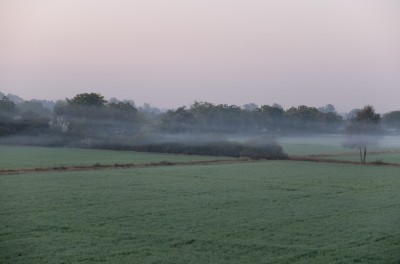
This January was cold with night temperatures below 10oC for all but one night. Most mornings we had breakfast outdoors in our garden in sub 8oC temperatures before the sun warmed us up. But no fog. Every day was clear and bright after a little early mist which hangs over the wheat being watered. Maximum temperature ranged between 20oC - 25oC.
The wheat was barely showing at the beginning of the month but by the end of January we were surrounded by a carpet of fresh green.
 The bright yellow mustard flowered all January and was abuzz with rock bees (apis dorsata) which have gathered along the branches of the large pipal tree. We also have apis florea, little bees, but apis cerana - the Indian honey bee - has lost its ecological niche to the European honey bee apis mellitus. Some hives of honey bees are to be seen around here but sections of the Jaipur-Agra road were lined with them for the mustard flowering season.
The bright yellow mustard flowered all January and was abuzz with rock bees (apis dorsata) which have gathered along the branches of the large pipal tree. We also have apis florea, little bees, but apis cerana - the Indian honey bee - has lost its ecological niche to the European honey bee apis mellitus. Some hives of honey bees are to be seen around here but sections of the Jaipur-Agra road were lined with them for the mustard flowering season.
As the mustard grew taller, it gave excellent cover to a family of nilgai with their young that had taken up residence. Every night they were shooed off with a bright torch aimed at them resolutely which made their eyes shine prominently in the darkness. Soon they learnt to look away from the torch so that their eyes did not shine in the beam of light and they could blend into the murky background without revealing their position. But their inquisitiveness gets the better of them and they can not help glancing in the direction of the torch. Even so it requires a pair of binoculars to properly spot them at a distance.
 Little Rani, born on 12th December continued to thrive and she often chose to keep Tikku company who had lost her male calf on 23rdDecember. Mottled mum, Meera, is in the foreground and Tikku in the centre ground. We gave her food to try to increase her milk production but the cost of the fodder was more than the value of the milk gained and we let her go dry. Rani was never spotted helping herself to Tikku’s milk which she might have done as she was free to roam around.
Little Rani, born on 12th December continued to thrive and she often chose to keep Tikku company who had lost her male calf on 23rdDecember. Mottled mum, Meera, is in the foreground and Tikku in the centre ground. We gave her food to try to increase her milk production but the cost of the fodder was more than the value of the milk gained and we let her go dry. Rani was never spotted helping herself to Tikku’s milk which she might have done as she was free to roam around.
 January and March in 2018 are unusual in the sense that each have two full moons. This photo is of the second or blue moon on 31st January. There was also a lunar eclipse but we couldn’t see it. Even in Bangalore, that international city of intelligent thinkers, it was noticed that the streets were very quiet during the eclipse as people hedged their bets and stayed indoors as they consider it inauspicious to be out during an eclipse, especially pregnant women.
January and March in 2018 are unusual in the sense that each have two full moons. This photo is of the second or blue moon on 31st January. There was also a lunar eclipse but we couldn’t see it. Even in Bangalore, that international city of intelligent thinkers, it was noticed that the streets were very quiet during the eclipse as people hedged their bets and stayed indoors as they consider it inauspicious to be out during an eclipse, especially pregnant women.

